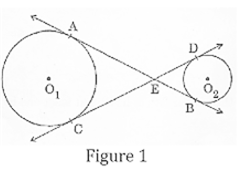 Short Answer Type
Short Answer TypeIn Figure 1, common tangents AB and CD to the two circles with centres O1 and O2 intersect at E. Prove that AB = CD.

The incircle of an isosceles triangle ABC, in which AB = AC, touches the sides BC, CA and AB at D, E and F respectively. Prove that BD = DC.
 Long Answer Type
Long Answer TypeProve that the tangent at any point of a circle is perpendicular to the radius through the point of contact.
Prove that opposite sides of a quadrilateral circumscribing a circle subtend supplementary angles at the centre of the circle.
 Short Answer Type
Short Answer TypeIf the angle between two tangents drawn from an external point P to a circle of radius a and centre O, is 60°, then find the length of OP.
Prove that the tangents drawn at the end points of a chord of a circle make equal angles with the chord.
 Long Answer Type
Long Answer TypeIn the given figure, XY and X’Y’ are two parallel tangents to a circle with centre O and another tangents AB with point of contact C, is intersecting XY at A and X’Y’ at B. Prove that ∠AOB = 90°.

 Multiple Choice Questions
Multiple Choice QuestionsIn Fig., the sides AB, BC and CA of a triangle ABC, touch a circle at P, Q and R respectively. If PA = 4 cm, BP = 3 cm and AC = 11 cm, then the length of BC (in cm) is

11
10
14
15
B.
10
it is know that the lengths of tangents drwan from a point outside a circle
are equal in length.
Therefore, we have;
AP = AR ........(1) (Tangents drawn from point A)
BP = BQ .........(2) (Tangents drawn from point B)
CQ = CR ..........(3) (Tangents drawn from point C)
Using the above equations,
AR = 4 cm ( AP = 4 cm, given)
BQ = 3 cm ( BP = 3 cm, given)
AC = 11 cm RC = 11 cm - 4 cm = 7 cm
Hence, BC = BQ + CQ = 3 CM + 7 CM = 10 cm.
